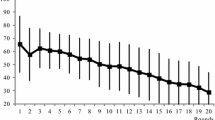Abstract
We study a type of complex system arising from economics, the lowest unique bid auction (LUBA) system which is a new generation of online markets. Different from the traditional auction in which the winner is who bids the highest price, in LUBA, the winner is whoever places the lowest of all unique bids. In this paper, we propose a multi-agent model to factually describes the human psychologies of the decision-making process in LUBA. The model produces bid-price distributions that are in excellent agreement with those from the real data, including the whole inverted-J shape which is a general feature of the real bid price distribution, and the exponential decreasing shape in the higher price range. This implies that it is possible for us to capture the essential features of human psychologies in the competitive environment as exemplified by LUBA and that we may provide significant quantitative insights into complex socio-economic phenomena.






Similar content being viewed by others
References
Ariely, D. (2000). Controlling the information flow: Effects on consumers decision making and preferences. Journal of Consumer Research, 27(2), 233–248.
Blackwell, D. (1962). Discrete dynamic programming. The Annals of Mathematical Statistics, 32(2), 719–726.
Busemeyer, J. R., & Townsend, J. T. (1993). Decision field theory: A dynamic-cognitive approach to decision making in an uncertain environment. Psychological Review, 100(3), 432–459.
Clauset, A., Shalizi, C. R., & Newman, M. E. (2009). Power-law distributions in empirical data. SIAM Review, 51(4), 661–703.
Diehl, E., & Sterman, J. D. (1995). Effects of feedback complexity on dynamic decision making. Organizational Behavior and Human Decision Processes, 62(2), 198–215.
Ho, W., Xu, X., & Dey, P. K. (2010). Multi-criteria decision making approaches for supplier evaluation and selection: A literature review. European Journal of Operational Research, 202(1), 16–24.
Houba, H., van der Laan, D., & Veldhuizen, D. (2011). Endogenous entry in lowest-unique sealed-bid auctions. Theory and Decision, 71(2), 269–295.
Krishna, V. (2009). Auction theory. San Diego, CA: Academic.
Ostling, R., Wang, J. T., Chou, E. Y., & Camerer, C. (2011). Testing game theory in the field: Swedish LUPI lottery games. American Economic Journal: Microeconomics, 3, 1–33.
Pigolotti, S., Bernhardsson, S., Juul, J., Galster, G., & Vivo, P. (2012). Equilibrium strategy and population-size effects in lowest unique bid auctions. Physical Review Letters, 108(8), 088701.
Radicchi, F., Baronchelli, A., & Amaral, L. A. (2012). Rationality, irrationality and escalating behavior in lowest unique bid auctions. PLoS One, 7(1), e29910.
Rapoport, A., Otsubo, H., Kim, B., & Stein, W. E. (2007). Unique bid auctions: Equilibrium solutions and experimental evidence. Social Science Research Network. http://ssrn.com/abstract=1001139.
Schwenk, C. R. (1984). Cognitive simplification processes in strategic decision-making. Strategic Management Journal, 5(2), 111–128.
Theodoni, P., Kovács, G., Greenlee, M. W., & Deco, G. (2011). Neuronal adaptation effects in decision making. The Journal of Neuroscience, 31(1), 234–246.
Zeng, Q., Davis, B. R., & Abbott, D. (2007). Reverse auction: The lowest unique positive integer game. Fluctuation and Noise Letters, 7(4), 439–447.
Zhang, J., Chen, Q., & Wang, Y. (2009). Zipf distribution in top Chinese firms and an economic explanation. Physica A: Statistical Mechanics and Its Applications, 388(10), 2020–2024.
Zhao, Y., Chen, Q., & Wang, Y. (2014). Bid distribution derived from consistent mixed strategy in lowest unique bid auction. International Journal of Modern Physics C, 25(05), 1440002.
Zhou, C., Dong, H., Hu, R., & Chen, Q. (2015). Smarter than others? Conjectures in lowest unique bid auctions. PLoS One, 10(4), e0122923.
Acknowledgments
We thank Professors Pigolotti and Radicchi for sharing the data related to LUBA research, some of which we used. Thanks also to Yougui Wang for opinions and Cancan Zhou for polishing in English. This work was supported by the NSFC under Grant No. 61174165 and Fundamental Research Funds for the Central Universities.
Author information
Authors and Affiliations
Corresponding author
Additional information
Rui Hu and Jinzhong Guo have contributed equally to this work.
Rights and permissions
About this article
Cite this article
Hu, R., Guo, J., Chen, Q. et al. The Psychological Force Model for Lowest Unique Bid Auction. Comput Econ 50, 655–667 (2017). https://doi.org/10.1007/s10614-016-9614-z
Accepted:
Published:
Issue Date:
DOI: https://doi.org/10.1007/s10614-016-9614-z




